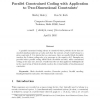Free Online Productivity Tools
i2Speak
i2Symbol
i2OCR
iTex2Img
iWeb2Print
iWeb2Shot
i2Type
iPdf2Split
iPdf2Merge
i2Bopomofo
i2Arabic
i2Style
i2Image
i2PDF
iLatex2Rtf
Sci2ools
TIT
2002
2002
Parallel constrained coding with application to two-dimensional constraints
A parallel constrained coding scheme is considered where p-blocks of raw data are encoded simultaneously into q tracks such that the contents of each track belong to a given constraint S. It is shown that as q increases, there are parallel block decodable encoders for S whose coding ratio, p=q, converges to the capacity of S. Examples are provided where parallel coding allows block decodable encoders, while conventional coding, at the same rate, does not. Parallel encoders are then applied as buildingblocks in the construction of block decodable encoders for certain families of two-dimensional constraints.
Encoders | Parallel Block | Raw Data | TIT 2002 |
| Added | 23 Dec 2010 |
| Updated | 23 Dec 2010 |
| Type | Journal |
| Year | 2002 |
| Where | TIT |
| Authors | Shirley Halevy, Ron M. Roth |
Comments (0)

